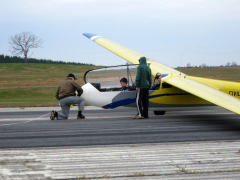Staff Sections
Main Content
Group 5 Squadrons Conduct Glider Operations at Triangle North Executive Airport
The tow rope is attached to the glider. Photo Credit: SM Heather Endre (click image to view full size)
Cape Fear and Brunswick County Composite Squadrons join forces to fly
12/30/2017–LOUISBURG, NC–On 2 December 2017, the Brunswick County Composite Squadron and the Cape Fear Composite Squadron combined forces to conduct Glider Operations at the Triangle North Executive Airport. After a long ride from Wilmington to Louisburg, they signed in, got a safety briefing, then were out to the flight line.
The Triangle North Executive Airport is a pretty busy place. On any given Saturday, if the weather is good, there are plenty of airplanes coming and going from the uncontrolled airport on the northeast side of Raleigh. Add to that the Civil Air Patrol (CAP) tow-plane and glider, sprinkle in a helicopter every now and then, and also the skydiving operation that takes place on the field on a pretty Saturday.
Hosted by the Franklin County Composite Squadron, glider operations is really a group effort. Cadets are allowed five glider orientation flights as a benefit of CAP membership and NC-145 stays busy helping the wing to host as many units as possible throughout the year.
Throughout the day, everyone stays busy making the whole operation work like a smoothly-oiled machine. The Cessna 182 tow-plane lines up on the runway, about a hundred feet in front of the glider, and the team goes to work, like a pit crew. One group hooks the tow rope to the tow-plane, closing the latch, giving the rope a tug, then signaling the pilot that it is hooked by waggling his rudder a little bit. A second team hooks up the rope to the glider, signaling the glider orientation pilot to open the hook, by showing him an open hand, and signaling to close the hook by closing their hand into a fist. The glider pilot then gives a "thumbs up" and the wing runner lifts the wing. After everyone is ready, the glider pilot waggles his rudder, and the signal is given for the tow-plane to power up and start the tow.
The wing runner cadet cradles the wing of the glider until there is enough airspeed to keep the wings level. This means that the cadet has to try to keep up with the glider, at a dead run. It does not take long for the glider to outrun the cadet and off the planes go down the runway. The tow-plane pulls the glider up to two thousand feet, then the glider releases, leaving the tow rope attached to the tow-plane.
It is calm and quiet in the glider. With no engine power it is a lot different than the powered flying we are normally used to. All you can hear is the sound of the wind sweeping by the canopy. Glider flying really teaches a pilot stick and rudder skills. The glider flight typically lasts about fifteen minutes and during that time the tow-plane flies down to drop the tow rope on a count given by the Air Boss. The tow plane slips to land on the runway and everyone sets everything up again for the next tow.
During their glider flight, the cadets get to fly the glider! The voice of the glider orientation pilot coaches them on how to make the glider rise on a thermal, and how to conduct coordinated turns, all while gravity provides the power to keep them in flight. On a clear day the sun adds energy for flight also, creating rising columns of air that can give the glider extra lift and prolong the ride. All too soon it is time for that sortie to come to an end and the glider announces that they are on the down-wind leg, preparing to land on the grass next to the runway. After the turn to base, then final, the glider gently touches down on its one wheel and rolls to a stop in front of the waiting ground crew, who start the process again. The glider ops process only stopped when a brief period of rain blew over the airfield and we broke for lunch.
All of the cadets received two flights that day and then they opened it up to the senior members who all got a flight. It is a special treat for those members who have not flown the glider before and for those that are not normally part of an aircrew. Operations continued until the sun was low in the sky and then the operation wraped up by tying down the glider and beginning the long trip home.
Sub Content
- My Account
- Member Login
- Register for an account
Search
- Recent Articles
- Cunningham Field Composite Squadron Hosts Air Operations Training and Familiarization
- NC Wing CyberPatriot Preliminary State Award Winners Announced
- Tar River Composite Squadron Cadets Compete in CyberPatriot Competition
- Civil Air Patrol Remembers Veterans for Christmas
